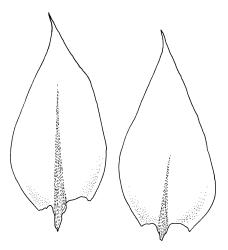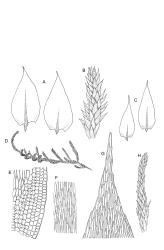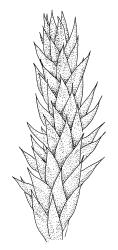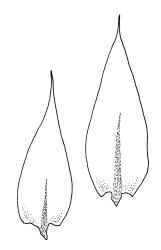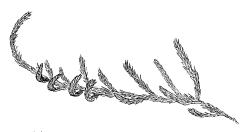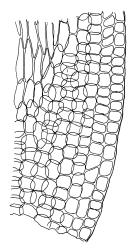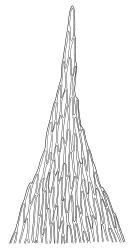- ≡ Hypnum lepturum Taylor, London J. Bot. 5: 64 (1846)
- ≡ Fabronia leptura (Taylor) Broth., Nat. Pflanzenfam. [Engler & Prantl] 1(3), 905 (1907)
- ≡ Juratzkaea leptura (Taylor) W.R.Buck, Rev. Bryol. Lichénol., n.s. 43: 319 (1977)
Plants small or medium-sized, lustrous, pale or dark green, forming loosely interwoven mats. Stems c. 10–30 mm, creeping and curving upwards from the substrate, subpinnately or irregularly branched, with fascicles of smooth, pale brown rhizoids at leaf bases, in cross-section with an ill-defined central strand and c. 3 layers of firm-walled, irregular cortical cells. Branches variable in length, mostly c. 3–8 mm but sometimes longer (to c. 20 mm), erect-ascendant and mostly strongly curved. Stem leaves erect-spreading or occasionally weakly complanate, (1.2–)1.5–2.0 × (0.45–)0.6–0.8 mm (excluding the smaller leaves near the stem apex), differing from branch leaves only by size. Branch leaves erect-spreading, ovate or ovate-lanceolate, gradually narrowed to a concolorous acuminate apex, concave and narrowed at base, often with one weak basal plication extending c. ⅓ –½ the leaf length, 0.8–1.4 × 0.4–0.5 mm; margins entire or less often weakly crenulate or with a few weak teeth, weakly reflexed at base on one or both sides, plane above; upper laminal cells linear, pointed at both ends, smooth, c. (45–)60–75(–90) × 6–7 µm; alar cells strongly differentiated, quadrate or oblate, mostly 9–13 µm wide, not porose, forming a large, opaque, and strongly concave group extending to and covering (on the adaxial surface) the costal base and (17–)20–30 cells up the margin. Costa stout and well-defined at base, strongly tapered, extending ½(–¾) the leaf length. Paraphyllia absent.
Dioicous. Perichaetia not seen. Perigonia scattered on ventral surface of stems, gemmiform, the perigonial leaves shorter (c. 0.5 mm) than vegetative and scarcely costate. Capsules not seen.
Catcheside 1980, fig. 203; Catcheside & Stone 1980, pls 1–2.
The lustrous appearance, the curved, short branches, and the creeping stems are distinctive. The slight suggestion, under a hand lens or stereoscope, of a glistening leaf margin (although why the plane margins should appear this way is not apparent) further facilitates recognition. Microscopically, the large, opaque, and weakly convex group of quadrate alar cells that extend over the base of the costa are diagnostic and the ± entire margins clearly distinguish it from Fabronia australis.
Ischyrodon lepturus is sometimes confused with the adventive Brachythecium albicans, a species that usually grows among introduced grasses, mostly on the South I. In I. lepturus the plants are less ascendant and have smaller, markedly less plicate, and broader, less acuminate leaf apices than in B. albicans. The stem leaves are not decurrent, while those of B. albicans are distinctly decurrent. Also, the alar cells of I. lepturus extend over the adaxial surface of the base of the costa (visible under the compound microscope) in a highly characteristic manner (but which is not illustrated here).
NI: N Auckland (only from offshore islands: HC, LB, GB), Wellington (Tītahi Bay, Island Bay, Kapiti I.); SI: Nelson (Stephens I., D’Urville I., Pūponga), Marlborough (Chetwode Is, Motuara I.); Ch.
Australasian? Mainland Australia*. Recorded from Tasmania by Dalton et al. (1991). Probably also in South Africa. Curiously, on the main islands of N.Z. there are two distinct centres of distribution: in the Hauraki Gulf and Cook Strait/Nelson regions. Detailed comparison of material from these two regions could be worthwhile.
Occurring on rock in coastal situations; apparently restricted to very low elevations and tolerant of some degree of salt spray. In South Australia Catcheside (1980) recorded it as usually occurring in sheltered gorges, presumably away from coastal influences.
Catcheside & Stone (1980), using South Australian material, published SEM micrographs and a detailed description of the peristome of Ischyrodon lepturus and confirmed Schelpe’s generic placement.
The relationship between the Australasian I. lepturus and the South African I. seriolus remains unresolved. Catcheside & Stone (1980) noted that material from South Africa has been annotated by J.H. Willis as "identical with Fabronia leptura (Taylor) Broth." Although they did not express a firm opinion as to the distinctness of the Australian from the South African species, Catcheside & Stone (1980, p. 100) noted minor ways in which they differ, primarily details of the peristome teeth insertion, degree of costal development in perichaetial leaves, and the length of upper laminal cells. These differences are not impressive and most evidence suggests that material from the two regions is conspecific, although no South African material has been available for comparison. Ischyrodon lepturus, described from Western Australia, has the earlier basionym of the two.



